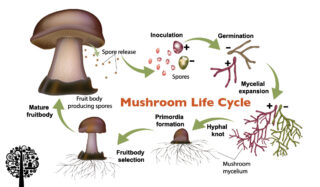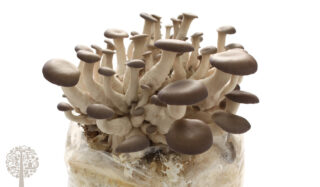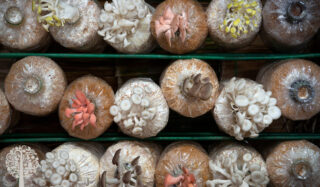Mushroom cultivation has become increasingly popular over the past few years due to its many ecological benefits, including growing nutrient-rich and delicious mushrooms in a small space with minimal inputs. However, growing mushrooms can be complex, requiring careful attention to detail and a good understanding of the various stages involved in the growth cycle. In this article, we’ll focus on the growth cycle of mushrooms using fruiting bags, one of the most common ways people cultivate gourmet and medicinal mushrooms. Fruiting bags are most commonly made of polypropylene, allowing the cultivator to sterilize various nutrient-rich substrates on which mushrooms grow. We’ll take a closer look at each growth cycle stage and explore some everyday situations cultivators encounter and how to identify them to ensure a successful flush.

Stage 1: Inoculation
Inoculation is the first and perhaps most crucial stage when using fruiting bags to grow mushrooms. During inoculation, spawn, spores, or liquid culture of the desired mushroom species are introduced to a sterilized fruiting bag filled with a nutrient-rich substrate. However, several obstacles may present during this stage that can prevent a successful flush of mushrooms. One common scenario is failing to properly sterilize the substrate before inoculation, which can lead to microorganisms multiplying and overcoming the substrate before the mushrooms. Therefore, it’s essential to use a pressure cooker or autoclave to ensure that the substrate is entirely sterile before inoculation. Autoclave tape ensures your method reaches sterile temperature by changing color at 121°C.

Another way to avoid contamination issues caused by under-sterilization is to purchase sterilized media from a reputable source. When using spawn as an inoculant, follow the recommended ratio of spawn-to-substrate for the specific mushroom species being grown. If too little spawn is used, the mycelium may not colonize the substrate properly. On the other hand, too much spawn can lead to rapid but weak mycelial growth. Using clean liquid cultures or spores from a reputable supplier can help minimize the risk of contamination and ensure that the desired mushroom species is introduced to the substrate. Working in a clean and sterile environment during inoculation is also essential to further reduce the risk of contamination. By taking these precautions, growers can increase their chances of a successful harvest and produce high-quality mushrooms.
Stage 2: Colonisation
After the inoculation stage, the colonization process begins. This stage involves mycelium growth throughout the substrate, which is the foundation for the eventual development of fruiting bodies. During colonization, it’s essential to maintain the proper temperature and humidity levels to support healthy mycelial growth. However, several issues can arise during this stage that will impact yields. One common problem is slow or uneven mycelial growth, which can be caused by inadequate moisture, insufficient oxygen, or incorrect temperature. To address this, growers will monitor the bags while colonizing and adjust the environmental conditions accordingly. Identifying contamination during colonization is crucial to prevent further spread down the line and maintain a continuous growth cycle. Contamination can occur for various reasons, including exposure to air due to an improperly sealed bag, inadequate sterilization, or the introduction of foreign bacteria or spores. Signs of contamination during colonization include unusual colors or odors in the substrate and abnormal or slow mycelial growth. Common contaminants include molds, bacteria, and yeast, often identified through visual inspection or an offputting smell. If contamination is detected, take immediate action to prevent further spread. Remove the contaminated bags from your healthy bags, seal them in a large garbage bag, and discard them as soon as possible. If you open one of the contaminated bags in your lab or grow area, you are opening yourself up to a mass contamination event, which leads to total crop failure. Growers should take precautions like wearing the appropriate PPE when working with their crops and ensuring all surfaces are clean and sanitized regularly.
Stage 3: Primordia Formation

After the mycelium has fully colonized the substrate, primordia formation is the next stage in the growth cycle. Primordia are small, pin-like protrusions that eventually develop into mature fruiting bodies. Ensuring your temperature and humidity controls are dialed in for this part of the growth cycle is crucial, as it will dictate how many pins develop, dramatically affecting your yield. For example, some mushroom species require a drop in temperature or increased humidity to trigger primordia formation. Others require increased fresh air exchange to promote pinning, often done by slicing an “x” in the side of the fruiting bag. Adding an opening to the fruiting bag helps orient the mushrooms where they should grow. Once primordia have formed, they will continue to develop into mature fruiting bodies over several days or weeks, depending on the species. Proper care during primordia formation is crucial to ensure a healthy and abundant harvest. Any environmental fluctuations or contamination at this stage can cause the primordia to abort or fail to develop into mature fruiting bodies.
Stage 4: Fruiting

The fruiting process is the final stage in the mushroom growth cycle. During this stage, primordia erupt into giant mushrooms that dwarf the small pins they once were. This often happens in a short window, so watching your mushrooms as they start to take off is essential. Environmental conditions during the fruiting stage are crucial for ensuring a healthy and abundant mushroom harvest. Mushrooms, similarly to humans, are mostly made of water, so ensuring the air has enough moisture in it is very important, as the mushrooms will dry out very quickly. But, like people, some mushrooms may require different parameters to thrive, so do your homework first. For example, some mushroom species require high humidity and low temperatures, while others require the opposite conditions. One issue that can occur during the fruiting stage is irregular fruiting, where some areas of the substrate produce more fruiting bodies than others, or the mushrooms grow at a variable rate. This is frequently caused by an improper pin-set being formed due to fluctuating temperatures or humidity conditions. Removing the entire fruiting body when harvesting is essential if you plan to do a second flush. Any piece of the fruiting body left behind will be prone to contamination, especially Trichoderma.
Level Of Difficulty: You Decide!
Mushroom cultivation using fruiting bags can be as complex or as simple as you need! If you are a hobbyist looking to try new things, starting with a pre-inoculated kit is the way to go, as you only need to worry about the fruiting stage of the mushrooms. If you want to get more involved, there are kits you can purchase that include a pre-sterilized substrate, PPE, and liquid culture so you can experience more of the process yourself! Successful mushroom cultivation involves careful attention to detail, including proper substrate sterilization before inoculation, maintaining the right temperature and humidity levels during colonization, and ensuring appropriate environmental conditions for primordia formation and fruiting. While challenges may arise during each stage, identifying and addressing them early will increase the chances of a successful harvest.